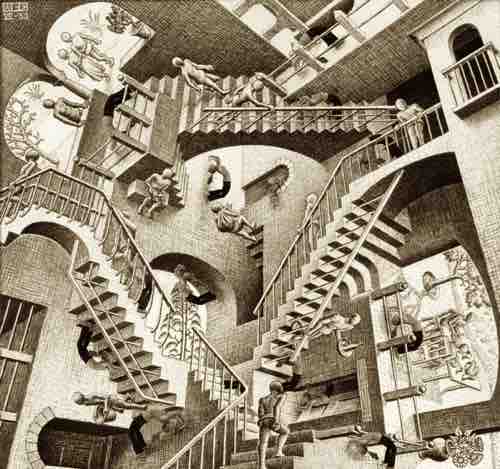
Escher and Technology

‘Relativity’ – lithograph print by M. C. Escher, December 1953
Ever think the world has gone crazy?
I have found that a good way to explain the inevitable confusion in trying to embrace the macro/micro perspectives that one needs when exploring human relationship with digital technology, is by using Maurits Escher’s lithograph Relativity as an analogy.
In Escher’s drawing every focal point has internal consistency and appears coherent – it makes sense if you just look at one piece. This is what happens when we just consider one aspect of technology, for example the benefits of Skype for maintaining long distance relationships. Look at the top right of the picture and you will see there are three people, two walking into a garden and one with his back to the garden looking out over the balcony at a man walking down the stairs that lead from the balcony. This, like the obvious usefulness of Skype, is internally coherent.
However, each focal point, such as the one described, is also linked to other focal points but in ways that do not make immediate coherent sense. For example, in the top middle of the picture we see the man walking down the stairs away from the balcony that made sense in the first region but there is also another man climbing the same stairs. The latter man is placed on a different plane and perspective. As a result when the two focal points are considered together as one complete picture the overall image appears shockingly confusing. This is what happens when you try to embrace in one picture the full range of human relationships with technology. When we think about specific single sectors, it can make sense but when you relate to multiple sectors it can appear incoherent.
Skype Example
With Skype we first see easy and cheap direct communication. Then you note that all this communication is different to what we are used to: it strips out some of the complexities of human interaction that add value, such as body language and other subtle nuances. But then you see that this changed communication is massive, allowing more contact with a wider variety of people, thereby bringing new values back to the total communication experience. Where does that leave us with regard to our communication? The Escher drawing gives this sense of coherent disconnect.
Like Escher’s Relativity, human engagement with digital technology is an endless series of linked systems. Some systems are nested systems – that is, they are systems within systems, and others are linked simply. What really adds to the confusion is that often the larger linked systems are in fact linked nested systems. Changes in one affect the internal and external systems with near endless iterations. This means that humans will have to progress from simple linear dimensional thinking and move towards networked thinking. Another way of explaining this is that humans will have to rapidly move from 2-dimensional thinking to 3-dimensional thinking if they have any hope of evolving at the rate that technology time is demanding of them.




